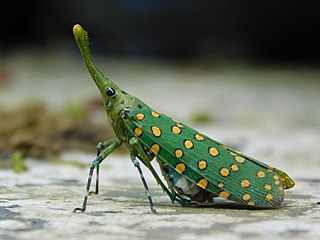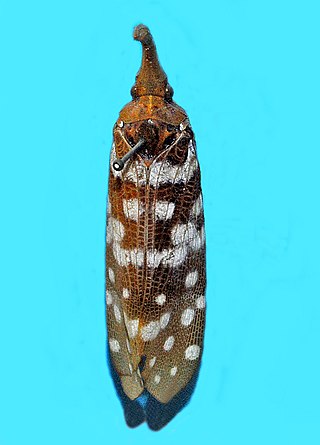
The family Fulgoridae is a large group of hemipteran insects, especially abundant and diverse in the tropics, containing over 125 genera worldwide. They are mostly of moderate to large size, many with a superficial resemblance to Lepidoptera due to their brilliant and varied coloration. Various genera and species are sometimes referred to as lanternflies or lanthorn flies, though they do not emit light.

Saiva is a genus of Asian planthoppers, family Fulgoridae. They are colourful insects, marked boldly in red, blue, white and black, with a prominent slender stalk like structure arising on the head that points upwards or forward. The known distribution is from India, through Indo-China to Borneo.

A planthopper is any insect in the infraorder Fulgoromorpha, in the suborder Auchenorrhyncha, a group exceeding 12,500 described species worldwide. The name comes from their remarkable resemblance to leaves and other plants of their environment and that they often "hop" for quick transportation in a similar way to that of grasshoppers. However, planthoppers generally walk very slowly. Distributed worldwide, all members of this group are plant-feeders, though few are considered pests. The infraorder contains only a single superfamily, Fulgoroidea. Fulgoroids are most reliably distinguished from the other Auchenorrhyncha by two features; the bifurcate ("Y"-shaped) anal vein in the forewing, and the thickened, three-segmented antennae, with a generally round or egg-shaped second segment (pedicel) that bears a fine filamentous arista.

Eurybrachidae is a small family of planthoppers with species occurring in parts of Asia, Australia and Africa. They are remarkable for the sophistication of their automimicry.

Pyrops candelaria is a species of planthopper often placed in the tribe Laternariini. This species has been recorded from: Guangdong, Guangxi, Cambodia, Vietnam, Hong Kong, Laos, Thailand and other parts of southeast Asia. It is the type of the genus Pyrops erected by Spinola in 1839.

Pyrops is a genus of planthoppers that occur primarily in southeast Asia, containing about 70 species. They are fairly large insects, with much of the length due to an elongated, upcurving, snout-like projection of the head. The wings are generally brightly patterned in contrasting colors, and they are popular among collectors.

Ricaniidae is a family of planthopper insects, containing over 400 species worldwide. The highest diversity is in tropical Africa and Asia and in Australia, with a few species occurring in the Palearctic and Neotropical realms. It is one of the smaller families in the planthopper superfamily Fulgoroidea.

The subfamily Aphaeninae is a group of hemipteran insects, especially abundant and diverse in the tropics. They belong to the Fulgoridae (fulgorids), though they are not among the better-known members of that family that are called "lantern bugs" or "lanternflies". In 2009, the first molecular analysis of the Fulgoridae challenged the existing structure of eight currently recognized subfamilies and eleven tribes.

Issidae is a family of planthoppers described by Spinola in 1839, belonging to the order Hemiptera, suborder Auchenorrhyncha superfamily Fulgoroidea.

Bythopsyrna is a genus of Asian planthoppers belonging to the family Flatidae.

Calyptoproctus is a genus of planthoppers in the family Fulgoridae and the type genus of subtribe Calyptoproctina; records are from central and south America.
Calyptoproctus elegans is a species of planthopper in the family Fulgoridae. It is found from Brazil north to Honduras.

Pyrops maculatus is a species of planthopper belonging to the family Fulgoridae. A population is found in Sri Lanka while another is known from southwestern India.

Lycorma is a genus of planthoppers native to Asia. The first species within the genus was described by Frederick William Hope in 1843 and the genus was formally established by Carl Stål in 1863.

The Fulgorinae are a sub-family of insects in the Auchenorrhyncha: which include the spectacular "lantern-bugs" and allied insects.
The Elicini are a tribe of planthoppers in the family Tropiduchidae. The type genus is Elica.

The subfamily Poiocerinae include Hemipteran insects in the family Fulgoridae, found especially in the tropics.
Desudaba is a genus of bugs in the family Fulgoridae, tribe Poiocerini and subtribe Calyptoproctina Metcalf, 1938. Records are from Australia and New Guinea.

Eurybrachys is a genus of bugs in the family Eurybrachidae. First formally named in 1834 by French entomologist Félix Édouard Guérin-Méneville, Eurybrachys is the type genus of the family Eurybrachidae. The spelling Eurybrachis, by the author, is considered an unaccepted orthographic variant. Species in this genus occur in Asia.
Elica is a monotypic genus of planthoppers containing the species Elica latipennis from Peninsular Malaysia.














